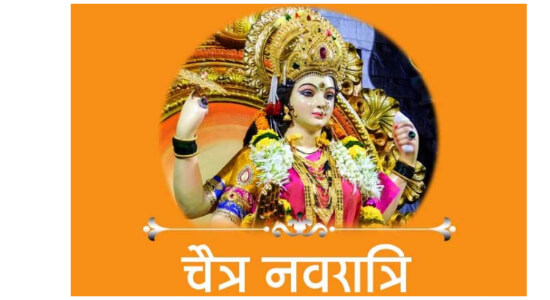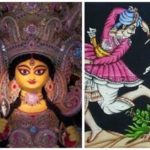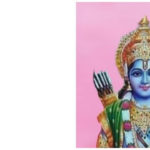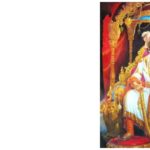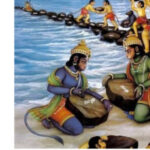Chaitra Navratri festival is a significant Hindu festival celebrated in India with great enthusiasm and devotion. It is observed during the Hindu month of Chaitra, which falls in March or April. It marks the beginning of the Hindu New Year. This festival lasts for nine days and is also known as Vasant Navaratri, as it is celebrated during the spring season.
Table of Contents
9-Day Chaitra Navaratri Festival

Navaratri is a combination of two words ‘nava’ meaning nine and ‘ratri’ meaning night. During this festival, devotees worship the nine forms of Goddess Durga, also known as Navadurga. Each day of the Chaitra Navaratri festival is dedicated to a specific form of the goddess.
Chaitra Navratri Significance & Celebration
Read all about Chaitra Navratri Festival in India. Know the significance and why Chaitra Navaratri Festival is celebrated.
Chaitra Navratri Festival – Worship of Maa Durga

Chaitra Navratri festival is dedicated to the worship of Goddess Durga, who is considered the embodiment of feminine power and energy. According to Hindu mythology, Durga is the warrior goddess who fought against the demon Mahishasura and emerged victorious. The festival marks the triumph of good over evil and is a time for seeking the blessings of the goddess for health, wealth, and prosperity.
The festival holds great significance for Hindus, especially in North India. It is believed that during this period, the goddess descends to the earth and blesses her devotees with health, wealth, and prosperity. The festival also marks the beginning of the Hindu New Year in some parts of India.
During the nine-day festival, devotees observe fasts, perform prayers and engage in various religious activities. Each day is dedicated to a different form of the goddess, and a special puja is performed to invoke her blessings.
Chaitra Navratri Puja
The first day of the Chaitra Navaratri festival is known as Ghatasthapana or Kalashsthapana. On this day, a Kalash (a pot made of copper or silver) filled with water and decorated with mango leaves is placed in the puja room. A coconut is placed over the Kalash and is covered with a red cloth. The Kalash is worshipped for nine days as the embodiment of the goddess, and on the tenth day, the water from the Kalash is distributed as prasad (holy water).
The next nine days of Navaratri are dedicated to the worship of Goddess Durga’s nine forms, which include Shailputri, Brahmacharini, Chandraghanta, Kushmanda, Skandamata, Katyayani, Kalaratri, Mahagauri, and Siddhidatri. Each day, devotees offer special prayers and perform rituals to the respective form of the goddess.
During the nine days of Navaratri, people also observe ‘Kanya Pujan’, where nine young girls, representing the nine forms of Goddess Durga, are invited to people’s homes, their feet are washed, and they are offered food and gifts.
The ritual involves offering the young girls food items such as poori, chana, and halwa. The food is considered prasad, which is believed to have the blessings of the Goddess Durga. They are worshipped and treated as manifestations of the Goddess Durga, who is the presiding deity of the Navaratri festival. This ritual is considered to be very auspicious, and it is believed that by performing this ritual, one can receive the blessings of Goddess Durga.
Significance of 9 Different colours during Chaitra Navaratri Festival
Each day of Chaitra Navratri is associated with a different colour, which has a special significance. The nine colours and their significance are as follows:
-
- Day 1 (Pratipada) – Yellow: This colour represents happiness, peace, and prosperity.
- Day 2 (Dwitiya) – Green: This colour is associated with new beginnings and growth.
- Day 3 (Tritiya) – Grey: This colour represents the destructive aspect of Goddess Durga.
- Day 4 (Chaturthi) – Orange: This colour represents energy and enthusiasm.
- Day 5 (Panchami) – White: This colour represents purity and peace.
- Day 6 (Sashti) – Red: This colour represents passion and power.
- Day 7 (Saptami) – Royal Blue: This colour represents calmness and serenity.
- Day 8 (Ashtami) – Pink: This colour represents hope and happiness.
- Day 9 (Navami) – Purple: This colour represents royalty and elegance.
During Chaitra Navratri, devotees wear clothes of the respective colours each day, and some even decorate their homes and temples with these colours. The nine colours also symbolize the nine different forms of Goddess Durga that are worshipped during Navratri.
Chaitra Navaratri Festival – Worship of Lord Rama

In Northern India, the Chaitra Navaratri festival is celebrated with great enthusiasm and is popularly known as ‘Ram Navami’. The festival marks the birthday of Lord Rama, who is considered to be one of the incarnations of Lord Vishnu. Devotees observe fasts and chant mantras in praise of Lord Rama. In some parts of Northern India, a huge fair is organized, and people dress up in traditional attire and participate in cultural activities.
Reading or listening to the Ramayana during Chaitra Navaratri is considered very auspicious by many Hindus. It is believed that reading or hearing the Ramayana during this time can bring peace, prosperity, and spiritual growth.
Many people perform Ramayana recitation or Kirtan during Chaitra Navaratri. Some also organize Ramayana plays or performances to depict the story of Lord Rama. This is believed to help in purifying the mind and attaining spiritual enlightenment.
Overall, reading or listening to the Ramayana during Chaitra Navaratri is a significant practice for many Hindus, as it is believed to bring positivity, prosperity, and spiritual growth.
Chaitra Navaratri is a time of reflection, purification, and devotion for Hindus, and is celebrated across India with different regional variations.
In conclusion, the Chaitra Navaratri festival is a significant Hindu festival celebrated in India with great enthusiasm and devotion. The festival marks the beginning of the spring season and is dedicated to worshipping the goddess Durga and her nine avatars. The festival is celebrated with religious rituals, feasting, and merry-making, and it is a time for people to come together and celebrate. It is a time to seek the blessings of goddess Durga and to promote unity and harmony.

Thanks for visiting our site nirvandiaries.com and taking the time to read this post.
If you wish to collaborate or work with us then reach us at [email protected]
We’d love it if you’d comment by sharing your thoughts on this post and share this post on social media and with your friends.
Follow our journey on our social media channels:
Facebook Twitter Instagram Pinterest
